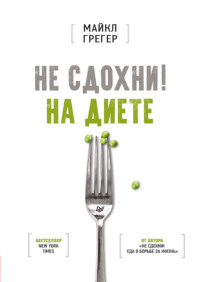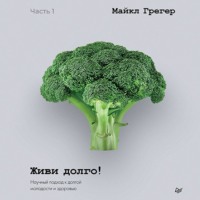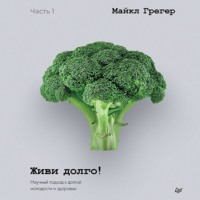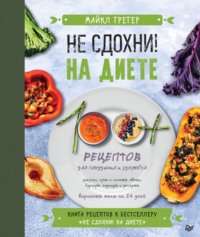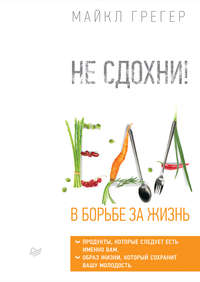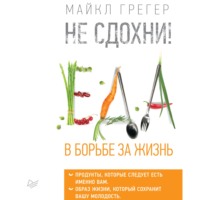
Полная версия
Живи долго! Научный подход к долгой молодости и здоровью
2591
Chen X, Jiao J, Zhuang P, et al. Current intake levels of potatoes and all-cause mortality in China: a population-based nationwide study. Nutrition. 2021;81:110902. https://pubmed.ncbi.nlm.nih.gov/32739659/
2592
Center for Science in the Public Interest. 10 Best Foods. https://cspinet.org/eating-healthy/what-eat/10-best-foods. Accessed January 5, 2022.; https://cspinet.org/eating-healthy/what-eat/10-best-foods
2593
Wilson CD, Pace RD, Bromfield E, Jones G, Lu JY. Consumer acceptance of vegetarian sweet potato products intended for space missions. Life Support Biosph Sci. 1998;5(3):339–46. https://pubmed.ncbi.nlm.nih.gov/11876201/
2594
Drewnowski A. New metrics of affordable nutrition: which vegetables provide most nutrients for least cost? J Acad Nutr Diet. 2013;113(9):1182–7. https://pubmed.ncbi.nlm.nih.gov/23714199/
2595
Sunthonkun P, Palajai R, Somboon P, Suan CL, Ungsurangsri M, Soontorngun N. Life-span extension by pigmented rice bran in the model yeast Saccharomyces cerevisiae. Sci Rep. 2019;9(1):18061. https://pubmed.ncbi.nlm.nih.gov/31792269/
2596
Chen W, Müller D, Richling E, Wink M. Anthocyanin-rich purple wheat prolongs the life span of Caenorhabditis elegans probably by activating the DAF-16/FOXO transcription factor. J Agric Food Chem. 2013;61(12):3047–53. https://pubmed.ncbi.nlm.nih.gov/23470220/
2597
Zuo Y, Peng C, Liang Y, et al. Black rice extract extends the lifespan of fruit flies. Food Funct. 2012;3(12):1271–9. https://pubmed.ncbi.nlm.nih.gov/22930061/
2598
Lu X, Zhou Y, Wu T, Hao L. Ameliorative effect of black rice anthocyanin on senescent mice induced by D-galactose. Food Funct. 2014;5(11):2892–7. https://pubmed.ncbi.nlm.nih.gov/25190075/
2599
Kano M, Takayanagi T, Harada K, Makino K, Ishikawa F. Antioxidative activity of anthocyanins from purple sweet potato, Ipomoera batatas cultivar Ayamurasaki. Biosci Biotechnol Biochem. 2005;69(5):979–88. https://pubmed.ncbi.nlm.nih.gov/15914919/
2600
Majid M, Nasir B, Zahra SS, Khan MR, Mirza B, Haq I. Ipomoea batatas L. Lam. ameliorates acute and chronic inflammations by suppressing inflammatory mediators, a comprehensive exploration using in vitro and in vivo models. BMC Complement Altern Med. 2018;18(1):216. https://pubmed.ncbi.nlm.nih.gov/30005651/
2601
Wang YJ, Zheng YL, Lu J, et al. Purple sweet potato color suppresses lipopolysaccharide-induced acute inflammatory response in mouse brain. Neurochem Int. 2010;56(3):424–30. https://pubmed.ncbi.nlm.nih.gov/19941923/
2602
Wu DM, Lu J, Zheng YL, Zhou Z, Shan Q, Ma DF. Purple sweet potato color repairs D-galactose-induced spatial learning and memory impairment by regulating the expression of synaptic proteins. Neurobiol Learn Mem. 2008;90(1):19–27. https://pubmed.ncbi.nlm.nih.gov/18316211/
2603
Sun C, Diao Q, Lu J, et al. Purple sweet potato color attenuated NLRP3 inflammasome by inducing autophagy to delay endothelial senescence. J Cell Physiol. 2019;234(5):5926–39. https://pubmed.ncbi.nlm.nih.gov/30585631/
2604
Su W, Zhang C, Chen F, et al. Purple sweet potato color protects against hepatocyte apoptosis through Sirt1 activation in high-fat-diet-treated mice. Food Nutr Res. 2020;64:10.29219/fnr.v64.1509. https://pubmed.ncbi.nlm.nih.gov/32110174/
2605
Han Y, Guo Y, Cui SW, Li H, Shan Y, Wang H. Purple Sweet Potato Extract extends lifespan by activating autophagy pathway in male Drosophila melanogaster. Exp Gerontol. 2021;144:111190. https://pubmed.ncbi.nlm.nih.gov/33301922/
2606
Zhang X, Yang Y, Wu Z, Weng P. The modulatory effect of anthocyanins from purple sweet potato on human intestinal microbiota in vitro. J Agric Food Chem. 2016;64(12):2582–90. https://pubmed.ncbi.nlm.nih.gov/26975278/
2607
Suda I, Ishikawa F, Hatakeyama M, et al. Intake of purple sweet potato beverage affects on serum hepatic biomarker levels of healthy adult men with borderline hepatitis. Eur J Clin Nutr. 2008;62(1):60–7. https://pubmed.ncbi.nlm.nih.gov/17299464/
2608
Willcox DC, Willcox BJ, Todoriki H, Suzuki M. The Okinawan diet: health implications of a low-calorie, nutrient-dense, antioxidant-rich dietary pattern low in glycemic load. J Am Coll Nutr. 2009;28(sup4):500S-16S. https://pubmed.ncbi.nlm.nih.gov/20234038/
2609
Shi Z, Zhang T, Byles J, Martin S, Avery JC, Taylor AW. Food habits, lifestyle factors and mortality among oldest old Chinese: the Chinese Longitudinal Healthy Longevity Survey (CLHLS). Nutrients. 2015;7(9):7562–79. https://pubmed.ncbi.nlm.nih.gov/26371039/
2610
Mejia SB, Messina M, Li SS, et al. A meta-analysis of 46 studies identified by the FDA demonstrates that soy protein decreases circulating LDL and total cholesterol concentrations in adults. J Nutr. 2019;149(6):968–81. https://pubmed.ncbi.nlm.nih.gov/31006811/
2611
Mosallanezhad Z, Mahmoodi M, Ranjbar S, et al. Soy intake is associated with lowering blood pressure in adults: a systematic review and meta-analysis of randomized double-blind placebo-controlled trials. Complement Ther Med. 2021;59:102692. https://pubmed.ncbi.nlm.nih.gov/33636295/
2612
Bazzano LA, Thompson AM, Tees MT, Nguyen CH, Winham DM. Non-soy legume consumption lowers cholesterol levels: a meta-analysis of randomized controlled trials. Nutr Metab Cardiovasc Dis. 2011;21(2):94–103. https://pubmed.ncbi.nlm.nih.gov/19939654/
2613
Mejia SB, Messina M, Li SS, et al. A meta-analysis of 46 studies identified by the FDA demonstrates that soy protein decreases circulating LDL and total cholesterol concentrations in adults. J Nutr. 2019;149(6):968–81. https://pubmed.ncbi.nlm.nih.gov/31006811/
2614
Tokede OA, Onabanjo TA, Yansane A, Gaziano JM, Djoussé L. Soya products and serum lipids: a meta-analysis of randomised controlled trials. Br J Nutr. 2015;114(6):831–43. https://pubmed.ncbi.nlm.nih.gov/21559039/
2615
Yan Z, Zhang X, Li C, Jiao S, Dong W. Association between consumption of soy and risk of cardiovascular disease: a meta-analysis of observational studies. Eur J Prev Cardiol. 2017;24(7):735–47. https://pubmed.ncbi.nlm.nih.gov/28067550/
2616
Nachvak SM, Moradi S, Anjom-Shoae J, et al. Soy, soy isoflavones, and protein intake in relation to mortality from all causes, cancers, and cardiovascular diseases: a systematic review and dose-response meta-analysis of prospective cohort studies. J Acad Nutr Diet. 2019;119(9):1483–1500.e17. https://pubmed.ncbi.nlm.nih.gov/31278047/
2617
D’elia L, Rossi G, Ippolito R, Cappuccio FP, Strazzullo P. Habitual salt intake and risk of gastric cancer: a meta-analysis of prospective studies. Clin Nutr. 2012;31(4):489–98. https://pubmed.ncbi.nlm.nih.gov/22296873/
2618
Kanda A, Hoshiyama Y, Kawaguchi T. Association of lifestyle parameters with the prevention of hypertension in elderly Japanese men and women: a four-year follow-up of normotensive subjects. Asia Pac J Public Health. 1999;11(2):77–81. https://pubmed.ncbi.nlm.nih.gov/11195162/
2619
Ito K. Review of the health benefits of habitual consumption of miso soup: focus on the effects on sympathetic nerve activity, blood pressure, and heart rate. Environ Health Prev Med. 2020;25(1):45. https://pubmed.ncbi.nlm.nih.gov/32867671/
2620
Kondo H, Tomari HS, Yamakawa S, et al. Long-term intake of miso soup decreases nighttime blood pressure in subjects with high-normal blood pressure or stage I hypertension. Hypertens Res. 2019;42(11):1757–67. https://pubmed.ncbi.nlm.nih.gov/31371810/
2621
Du DD, Yoshinaga M, Sonoda M, Kawakubo K, Uehara Y. Blood pressure reduction by Japanese traditional Miso is associated with increased diuresis and natriuresis through dopamine system in Dahl salt-sensitive rats. Clin Exp Hypertens. 2014;36(5):359–66. https://pubmed.ncbi.nlm.nih.gov/24047246/
2622
Willcox BJ, Willcox DC. Caloric restriction, caloric restriction mimetics, and healthy aging in Okinawa: controversies and clinical implications. Curr Opin Clin Nutr Metab Care. 2014;17(1):51–8. https://pubmed.ncbi.nlm.nih.gov/24316687/
2623
Iso H, Kubota Y. Nutrition and disease in the Japan Collaborative Cohort Study for evaluation of cancer (JACC). Asian Pac J Cancer Prev. 2007;8 Suppl:35–80. https://pubmed.ncbi.nlm.nih.gov/18260705/
2624
Lashmanova E, Proshkina E, Zhikrivetskaya S, et al. Fucoxanthin increases lifespan of Drosophila melanogaster and Caenorhabditis elegans. Pharmacol Res. 2015;100:228–41. https://pubmed.ncbi.nlm.nih.gov/26292053/
2625
Zhao T, Zhang Q, Qi H, Liu X, Li Z. Extension of life span and improvement of vitality of Drosophila melanogaster by long-term supplementation with different molecular weight polysaccharides from Porphyra haitanensis. Pharmacol Res. 2008;57(1):67–72. https://pubmed.ncbi.nlm.nih.gov/18221885/
2626
Wada K, Nakamura K, Tamai Y, et al. Seaweed intake and blood pressure levels in healthy pre-school Japanese children. Nutr J. 2011;10:83. https://pubmed.ncbi.nlm.nih.gov/21827710/
2627
Ono A, Shibaoka M, Yano J, Asai Y, Fujita T. Eating habits and intensity of medication in elderly hypertensive outpatients. Hypertens Res. 2000;23(3):195–200. https://pubmed.ncbi.nlm.nih.gov/10821126/
2628
Teas J, Baldeón ME, Chiriboga DE, Davis JR, Sarriés AJ, Braverman LE. Could dietary seaweed reverse the metabolic syndrome? Asia Pac J Clin Nutr. 2009;18(2):145–54. https://pubmed.ncbi.nlm.nih.gov/19713172/
2629
Ma W, He X, Braverman L. Iodine content in milk alternatives. Thyroid. 2016;26(9):1308–10. https://pubmed.ncbi.nlm.nih.gov/27358189/
2630
Flachowsky G, Franke K, Meyer U, Leiterer M, Schöne F. Influencing factors on iodine content of cow milk. Eur J Nutr. 2014;53(2):351–65. https://pubmed.ncbi.nlm.nih.gov/24185833/
2631
Teas J, Pino S, Critchley A, Braverman LE. Variability of iodine content in common commercially available edible seaweeds. Thyroid. 2004;14(10):836–41. https://pubmed.ncbi.nlm.nih.gov/15588380/
2632
Combet E. Iodine status, thyroid function, and vegetarianism. In: Vegetarian and Plant-Based Diets in Health and Disease Prevention. Elsevier; 2017:769–90. https://worldcat.org/title/988275855
2633
Willcox DC, Willcox BJ, Todoriki H, Suzuki M. The Okinawan diet: health implications of a low-calorie, nutrient-dense, antioxidant-rich dietary pattern low in glycemic load. J Am Coll Nutr. 2009;28 Suppl:500S-16S. https://pubmed.ncbi.nlm.nih.gov/20234038/
2634
Sánchez JE, Jiménez-Pérez G, Liedo P. Can consumption of antioxidant rich mushrooms extend longevity?: antioxidant activity of Pleurotus spp. and its effects on Mexican fruit flies’ (Anastrepha ludens) longevity. Age (Dordr). 2015;37(6):107. https://pubmed.ncbi.nlm.nih.gov/26499817/
2635
Beelman RB, Kalaras MD, Phillips AT, Richie JP. Is ergothioneine a ‘longevity vitamin’ limited in the American diet? J Nutr Sci. 2020;9:e52. https://pubmed.ncbi.nlm.nih.gov/33244403/
2636
Beelman RB, Kalaras MD, Phillips AT, Richie JP. Is ergothioneine a ‘longevity vitamin’ limited in the American diet? J Nutr Sci. 2020;9:e52. https://pubmed.ncbi.nlm.nih.gov/33244403/
2637
Ames BN. Prolonging healthy aging: longevity vitamins and proteins. Proc Natl Acad Sci U S A. 2018;115(43):10836–44. https://pubmed.ncbi.nlm.nih.gov/30322941/
2638
Smith E, Ottosson F, Hellstrand S, et al. Ergothioneine is associated with reduced mortality and decreased risk of cardiovascular disease. Heart. 2020;106(9):691–7. https://pubmed.ncbi.nlm.nih.gov/31672783/
2639
Paul BD, Snyder SH. The unusual amino acid L-ergothioneine is a physiologic cytoprotectant. Cell Death Differ. 2010;17(7):1134–40. https://pubmed.ncbi.nlm.nih.gov/19911007/
2640
Beelman RB, Kalaras MD, Phillips AT, Richie JP. Is ergothioneine a ‘longevity vitamin’ limited in the American diet? J Nutr Sci. 2020;9:e52. https://pubmed.ncbi.nlm.nih.gov/33244403/
2641
Beelman RB, Kalaras MD, Richie JP. Micronutrients and bioactive compounds in mushrooms: a recipe for healthy aging? Nutr Today. 2019;54(1):16–22. https://journals.lww.com/nutritiontodayonline/Abstract/2019/01000/Micronutrients_and_Bioactive_Compounds_in.5.aspx
2642
Ba DM, Gao X, Al-Shaar L, et al. Prospective study of dietary mushroom intake and risk of mortality: results from continuous National Health and Nutrition Examination Survey (NHANES) 2003–2014 and a meta-analysis. Nutr J. 2021;20(1):80. https://pubmed.ncbi.nlm.nih.gov/34548082/
2643
Cheah IK, Feng L, Tang RMY, Lim KHC, Halliwell B. Ergothioneine levels in an elderly population decrease with age and incidence of cognitive decline; a risk factor for neurodegeneration? Biochem Biophys Res Commun. 2016;478(1):162–7. https://pubmed.ncbi.nlm.nih.gov/27444382/
2644
Kameda M, Teruya T, Yanagida M, Kondoh H. Frailty markers comprise blood metabolites involved in antioxidation, cognition, and mobility. Proc Natl Acad Sci U S A. 2020;117(17):9483–9. https://pubmed.ncbi.nlm.nih.gov/32295884/
2645
Cheah IK, Feng L, Tang RMY, Lim KHC, Halliwell B. Ergothioneine levels in an elderly population decrease with age and incidence of cognitive decline; a risk factor for neurodegeneration? Biochem Biophys Res Commun. 2016;478(1):162–7. https://pubmed.ncbi.nlm.nih.gov/27444382/
2646
Lagrange E, Vernoux JP. Warning on false or true morels and button mushrooms with potential toxicity linked to hydrazinic toxins: an update. Toxins (Basel). 2020;12(8):482. https://pubmed.ncbi.nlm.nih.gov/32751277/
2647
Heer RS, Patel NB, Mandal AKJ, Lewis F, Missouris CG. Not a fungi to be with: shiitake mushroom flagellate dermatitis. Am J Emerg Med. 2020;38(2):412.e1–2. https://pubmed.ncbi.nlm.nih.gov/31864870/
2648
Stijve T, Pittet A. Absence of agaritine in Pleurotus species and in other cultivated and wild-growing mushrooms not belonging to the genus Agaricus. Dtsch Lebensm-Rundsch. 2000;96(7):251–4. https://www.researchgate.net/publication/286669322_Absence_of_Agaritine_in_Pleurotus_species_and_in_other_cultivated_and_wild-growing_mushrooms_not_belonging_to_the_genus_Agaricus
2649
Money NP. Are mushrooms medicinal? Fungal Biol. 2016;120(4):449–53. https://pubmed.ncbi.nlm.nih.gov/27020147/
2650
Money NP. Are mushrooms medicinal? Fungal Biol. 2016;120(4):449–53. https://pubmed.ncbi.nlm.nih.gov/27020147/
2651
Litten W. The most poisonous mushrooms. Sci Am. 1975;232(3):90–101. https://pubmed.ncbi.nlm.nih.gov/1114308/
2652
Lim CS, Chhabra N, Leikin S, Fischbein C, Mueller GM, Nelson ME. Atlas of select poisonous plants and mushrooms. Dis Mon. 2016;62(3):41–66. https://pubmed.ncbi.nlm.nih.gov/26965743/
2653
Грибы рода Amanita. В Европе это Amanita virosa, а в восточной и западной части Северной Америки – A. bisporigera и A. ocreata. В России известен как бледная поганка (Amanita phalloides). – Примеч. ред.
2654
Culliton BJ. The destroying angel: a story of a search for an antidote. Science. 1974;185(4151):600–1. https://pubmed.ncbi.nlm.nih.gov/17791229/
2655
Loyd AL, Richter BS, Jusino MA, et al. Identifying the “mushroom of immortality”: assessing the Ganoderma species composition in commercial reishi products. Front Microbiol. 2018;9:1557. https://pubmed.ncbi.nlm.nih.gov/30061872/
2656
Wang J, Cao B, Zhao H, Feng J. Emerging roles of Ganoderma lucidum in anti-aging. Aging Dis. 2017;8(6):691–707. https://pubmed.ncbi.nlm.nih.gov/29344411/
2657
Pan Y, Lin Z. Anti-aging effect of Ganoderma (Lingzhi) with health and fitness. Adv Exp Med Bio. 2019;1182:299–309. https://pubmed.ncbi.nlm.nih.gov/31777025/
2658
Cuong VT, Chen W, Shi J, et al. The anti-oxidation and anti-aging effects of Ganoderma lucidum in Caenorhabditis elegans. Exp Gerontol. 2019;117:99–105. https://pubmed.ncbi.nlm.nih.gov/28750751/
2659
Wang J, Cao B, Zhao H, Feng J. Emerging roles of Ganoderma lucidum in anti-aging. Aging Dis. 2017;8(6):691–707. https://pubmed.ncbi.nlm.nih.gov/29344411/
2660
Hsu KD, Cheng KC. From nutraceutical to clinical trial: frontiers in Ganoderma development. App Microbiol Biotechnol. 2018;102(21). https://pubmed.ncbi.nlm.nih.gov/30182215/
2661
Loyd AL, Richter BS, Jusino MA, et al. Identifying the “mushroom of immortality”: assessing the Ganoderma species composition in commercial reishi products. Front Microbiol. 2018;9:1557. https://pubmed.ncbi.nlm.nih.gov/30061872/
2662
Loyd AL, Richter BS, Jusino MA, et al. Identifying the “mushroom of immortality”: assessing the Ganoderma species composition in commercial reishi products. Front Microbiol. 2018;9:1557. https://pubmed.ncbi.nlm.nih.gov/30061872/
2663
Totelin L. When foods become remedies in ancient Greece: The curious case of garlic and other substances. J Ethnopharmacol. 2015;167:30–7. https://pubmed.ncbi.nlm.nih.gov/25173971/
2664
Shi X, Lv Y, Mao C, et al. Garlic consumption and all-cause mortality among Chinese oldest-old individuals: a population-based cohort study. Nutrients. 2019;11(7):E1504. https://pubmed.ncbi.nlm.nih.gov/31262080/
2665
Lau KK, Chan YH, Wong YK, et al. Garlic intake is an independent predictor of endothelial function in patients with ischemic stroke. J Nutr Health Aging. 2013;17(7):600–4. https://pubmed.ncbi.nlm.nih.gov/23933870/
2666
Mahdavi-Roshan M, Mirmiran P, Arjmand M, Nasrollahzadeh J. Effects of garlic on brachial endothelial function and capacity of plasma to mediate cholesterol efflux in patients with coronary artery disease. Anatol J Cardiol. 2017;18(2):116–21. https://pubmed.ncbi.nlm.nih.gov/28554988/
2667
Mahdavi-Roshan M, Zahedmehr A, Mohammad-Zadeh A, et al. Effect of garlic powder tablet on carotid intima-media thickness in patients with coronary artery disease: a preliminary randomized controlled trial. Nutr Health. 2013;22(2):143–55. https://pubmed.ncbi.nlm.nih.gov/25573347/
2668
Shabani E, Sayemiri K, Mohammadpour M. The effect of garlic on lipid profile and glucose parameters in diabetic patients: a systematic review and meta-analysis. Prim Care Diabetes. 2019;13(1):28–42. https://pubmed.ncbi.nlm.nih.gov/30049636/
2669
Xiong XJ, Wang PQ, Li SJ, Li XK, Zhang YQ, Wang J. Garlic for hypertension: a systematic review and meta-analysis of randomized controlled trials. Phytomedicine. 2015;22(3):352–61. https://pubmed.ncbi.nlm.nih.gov/25837272/
2670
Atkin M, Laight D, Cummings MH. The effects of garlic extract upon endothelial function, vascular inflammation, oxidative stress and insulin resistance in adults with type 2 diabetes at high cardiovascular risk. A pilot double blind randomized placebo controlled trial. J Diabetes Complications. 2016;30(4):723–7. https://pubmed.ncbi.nlm.nih.gov/26954484/
2671
Soleimani D, Paknahad Z, Askari G, Iraj B, Feizi A. Effect of garlic powder consumption on body composition in patients with nonalcoholic fatty liver disease: a randomized, double-blind, placebo-controlled trial. Adv Biomed Res. 2016;5:2. https://pubmed.ncbi.nlm.nih.gov/26955623/
2672
Shabani E, Sayemiri K, Mohammadpour M. The effect of garlic on lipid profile and glucose parameters in diabetic patients: a systematic review and meta-analysis. Prim Care Diabetes. 2019;13(1):28–42. https://pubmed.ncbi.nlm.nih.gov/30049636/
2673
Rajan TV, Hein M, Porte P, Wikel S. A double-blinded, placebo-controlled trial of garlic as a mosquito repellant: a preliminary study. Med Vet Entomol. 2005;19(1):84–9. https://pubmed.ncbi.nlm.nih.gov/15752181/
2674
Stjernberg L, Berglund J. Garlic as an insect repellent. JAMA. 2000;284(7):831. https://pubmed.ncbi.nlm.nih.gov/10938169/
2675
Tunón H. Garlic as a tick repellent. JAMA. 2001;285(1):41–2. https://pubmed.ncbi.nlm.nih.gov/11150101/
2676
Yusof YAM. Gingerol and its role in chronic diseases. Adv Exp Med Biol. 2016;929:177–207. https://pubmed.ncbi.nlm.nih.gov/27771925/
2677
Liu J, Shi JZ, Yu LM, Goyer RA, Waalkes MP. Mercury in traditional medicines: is cinnabar toxicologically similar to common mercurials? Exp Biol Med (Maywood). 2008;233(7):810–7. https://pubmed.ncbi.nlm.nih.gov/18445765/
2678
Anh NH, Kim SJ, Long NP, et al. Ginger on human health: a comprehensive systematic review of 109 randomized controlled trials. Nutrients. 2020;12(1):E157. https://pubmed.ncbi.nlm.nih.gov/31935866/
2679
Bodagh MN, Maleki I, Hekmatdoost A. Ginger in gastrointestinal disorders: a systematic review of clinical trials. Food Sci Nutr. 2018;7(1):96–108. https://pubmed.ncbi.nlm.nih.gov/30680163/
2680
Mowrey DB, Clayson DE. Motion sickness, ginger, and psychophysics. Lancet. 1982;1(8273):655–7. https://pubmed.ncbi.nlm.nih.gov/30680163/
2681
Palatty PL, Haniadka R, Valder B, Arora R, Baliga MS. Ginger in the prevention of nausea and vomiting: a review. Crit Rev Food Sci Nutr. 2013;53(7):659–69. https://pubmed.ncbi.nlm.nih.gov/23638927/
2682
Adib-Hajbaghery M, Hosseini FS. Investigating the effects of inhaling ginger essence on post-nephrectomy nausea and vomiting. Complement Ther Med. 2015;23(6):827–31. https://pubmed.ncbi.nlm.nih.gov/26645524/
2683
Bartels EM, Folmer VN, Bliddal H, et al. Efficacy and safety of ginger in osteoarthritis patients: a meta-analysis of randomized placebo-controlled trials. Osteoarthritis Cartilage. 2015;23(1):13–21. https://pubmed.ncbi.nlm.nih.gov/25300574/
2684
Khayat S, Kheirkhah M, Behboodi Moghadam Z, Fanaei H, Kasaeian A, Javadimehr M. Effect of treatment with ginger on the severity of premenstrual syndrome symptoms. ISRN Obstet Gynecol. 2014;2014:792708. https://pubmed.ncbi.nlm.nih.gov/24944825/
2685
Ozgoli G, Goli M, Moattar F. Comparison of effects of ginger, mefenamic acid, and ibuprofen on pain in women with primary dysmenorrhea. J Altern Complement Med. 2009;15(2):129–32. https://pubmed.ncbi.nlm.nih.gov/19216660/







